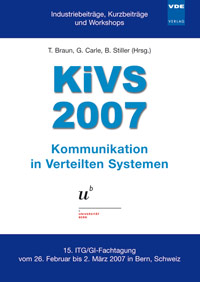UN/CEFACT Service-Oriented Architecture - Enabling Both Semantic And Application Interoperability
Konferenz: KiVS 2007 - Kommunikation in Verteilten Systemen - 15. ITG/GI-Fachtagung
26.02.2007 - 02.03.2007 in Bern, Schweiz
Tagungsband: KiVS 2007
Seiten: 12Sprache: EnglischTyp: PDF
Persönliche VDE-Mitglieder erhalten auf diesen Artikel 10% Rabatt
Autoren:
Schroth, Christoph; Janner, Till (SAP Research CEC, Blumenbergplatz 9, 9000 St.Gallen, Switzerland)
Schroth, Christoph; Janner, Till (Institute for Media and Communications Management, University of St. Gallen, Blumenbergplatz 9, 9000 St.Gallen, Switzerland)
Stuhec, Gunther (SAP AG, Dietmar-Hopp-Allee 16, 69190 Walldorf, Germany)
Inhalt:
Service-Oriented Architectures are about to emerge as the next-generation standard for seamless and automatized e-Business infrastructures and cross-organizational Enterprise Application Integration. With the help of unified interfaces, individual systems’ particularities can be hidden, thereby facilitating the exchange of data between heterogeneous applications. However, existing concepts mainly concentrate on technological issues and must be extended toward the semantic level to ensure that different applications have the same understanding of the business meaning of services. We propose a novel composite of several methodologies issued by the UN/CEFACT that bridges the semantic gap existing in current SOA deployments by introducing a loose coupling between the meaning of business data and its representation. This standards composite builds upon an evolutionary and collaborative approach and supports the modeling of both commonly comprehensible business documents and collaboration processes.


